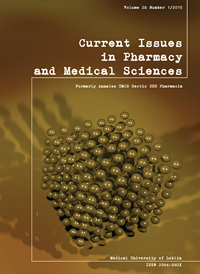Local administrative-territorial specificity dermatoglyphics of men in Ukraine affected by caries at various levels of intensity
DOI:
https://doi.org/10.1515/cipms-2015-0043Keywords:
caries, the average level intensity of infestation, dermatoglyphics, somatically healthy men, administrative-territorial regions of UkraineAbstract
We found differences in administrative-territorial distributions of dermatoglyphics with regard to somatic healthy men of I adulthood with low and moderate levels intensity of caries. However, separate dermatoglyphics complexes of men with low levels intensity of caries, typical for any region of Ukraine, were not found. The data obtained from the western and southern regions of the country is particularly interesting. This, we believe, is a manifestation of population-regional particularities of the gene pool of Ukrainian men that corresponds to markers of greater physical health than to markers of the progression of the course of caries that is of low intensity. The greatest number of differences by indicator dermatoglyphics is evidenced in men with a medium level intensity of caries. This is concentrated in territorial segments: west↔center↔south and north↔center↔south. Moreover, a great amount of differences are seen in territorial segments: center west↔center↔north and south↔center↔east, while the least difference, albeit still numerous, is noticeable in territorial segments: north↔center↔east. The obtained data are interpreted by us as a manifestation of predisposition to the course of caries of a medium level of affection which is based on differences in the structure of the gene pool of the Ukrainian male population.
References
1. Borisenko A.V., Shinkaruk-Dykovytska M.M.: On the issue of the genetic component in lesions of tooth by caries of varying intensity. The world of medicine and biology, 4, 47, 2014.
2. Cummins H., Midlo Ch.: Finger Prints, Palms and Soles. An Introduction to Dermatoglyphics. Philadelphia, 300, 1961.
3. Danilenko G.M. et al. Hygienic screening-assessment of the implementation health forming innovations in secondary schools. Kharkiv, 76, 2006.
4. Delaunay N.L., Solonichenko V.G.: Adaptive phenotypes of human in physiology and medicine. The successes of Physiological Sciences, 30, 2, 1999.
5. Gladkova T.D.: Skin patterns of hand and foot in monkeys and humans. Moscow, Science, 151, 1966.
6. Khit G.L., Shirobokov I.G., Slavolyubova I.A. Dermatoglyphics in anthropology. St. Petersburg, 376, 2013.
7. Okushko V.R.: Genetic and ectogenetic factors forming dental rows. Biomedical and biosocial anthropology, 2, 2004.
8. Pochtarenko V.A., Yakushevich O.O.: Genetics and periodontics. The difficulties of a long journey. Dentistry for all, 4, 2008.
9. Pshenichnov A.S.: The structure of the gene pool of Ukrainians from data on polymorphism of mitochondrial DNA and Y chromosome. Moscow, 191, 2007.
10. Segeda S.P.: Anthropological composition of the Ukrainian people: ethnogenetic aspects. Kyiv, 28, 2002.
11. Shinkaruk-Dykovytska M.M.: Indicators of subjective estimation of the state periodontal tissues in somatically healthy men from different regions of Ukraine. Ukrainian medical almanac. 15, 6, 2012.
12. Shinkaruk-Dykovytska M.M.: Indicators of use of oral care products in somatically healthy men from different regions of Ukraine. Ukrainian medical almanac. 15, 5, 2012.
13. Shinkaruk-Dykovytska M.M. Medical and social factors living conditions of somatically healthy men from different environmental and administrative regions of Ukraine. Biomedical and biosocial anthropology. 19, 2012.
14. Shinkaruk-Dykovytska M.M. Prognostic value of palmar dermatoglyphics signs concerning possible variants of caries by the level of its intensity lesion. Ukrainian morphological almanac, 12, 3, 2014.
15. Volkov E.A., Yanushevich O.O. Therapeutic dentistry: a tutorial. GEOTAR - Media, 168, 2013.
Downloads
Published
Issue
Section
License
Copyright (c) 2015 Authors

This work is licensed under a Creative Commons Attribution-NonCommercial-NoDerivatives 3.0 Unported License.


